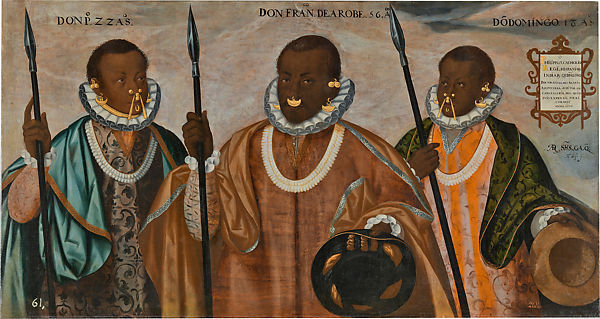Afro-Ecuadorians make up roughly 10% of Ecuador’s population, putting them at 1 – 2 million. The majority of Afro-Ecuadorians live in northern coastal regions, in the province of Esmeraldas as well as in the Valle del Chota in the Imbabura Province. The capital Quito and the city of Guayaquil both have a significant black presence.
Enslaved Africans were first trafficked to Ecuador in 1553 by Jesuit preists. Afro-Ecuadorian slaves worked in agriculture, gold mining, domestic work and ranching. There was a particularly high number of slaves in the Choto Valley were enslaved Africans grew cotton and sugarcane.

This famous painting by Andrés Sánchez Galque depicts Afro-Ecuadorian Francisco de Arobe and his sons, Pedro and Domingo, during an official visit to Quito in 1598. Francisco was a political leader from the Esmeraldas coast who swore allegiance to the Spanish king in exchange for the governorship of an extensive region populated by Afro-Ecuadorians.
There are two important dates regarding the abolition of slavery in Ecuador. In 1821 the Spanish crown outlawed international slave trafficking, though this did not mean the immediate emancipation of slaves on Latin American soil. The second date was 1852, when the ratification of the Fifth Constitution meant landowners were compensated by the government for freeing their slaves.
The rich cultural heritage from the African ancestors lives on in the Afro-Ecuadorian population today. Afro-Ecuadorian culture is famous for Marimba music. The name is taken from the main instrument used in the genre which is the marimbas. Afro-Ecuadorian dishes contain beans, chicken, fish, rice and plantain, which speaks to their African culinary heritage.
In 2006 the Collective Rights of Black and Afro-Ecuadorian Peoples law was passed. Two organizations dedicated to advocating Afro-Ecuadorian social and political rights include The Afro-Ecuadorian Development Council (CONDAE) and the Afro-Ecuadorian Development Corporation (CODAE). These organizations work with the government to inform policies and strategies for improving black communities.
Since 1997 October 2nd has been celebrated as Afro-Ecuadorian day. Across Esmeraldas and other regions with a high black population, there are religious, cultural and artistic events in celebration of their African heritage.